#Edwardian/Victorian transition fashion
Text
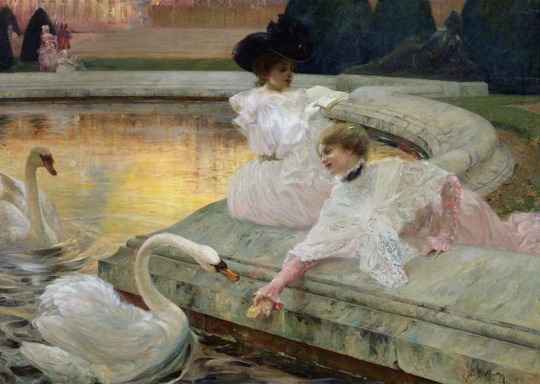
The Swans, Joseph Marius Alvy. 1900.
#aesthetic#art#art history#fashion#historical fashion#historical art#women in art#gilded age#edwardian aesthetic#victorian aesthetic#Edwardian/Victorian transition fashion#edwardian women#victorian women#1900s clothing#1900s art#1900s fashion#1900#swan#swans#women#pink aesthetic#sunset aesthetic
510 notes
·
View notes
Note
I'm new to the historical costuming and historybounding community and I noticed something odd and I wnated to know your opinion about it.
1850s/60s clothes are essentially nonexistent in the community at large. Every now and again, someone will make a Little Women inspired something, but that's it. No one seems to dislike this period, but no one seems to love it either?
Which confuses me so much because I would have assumed it to be one of the most popular styles, the way that the 1890s are in actuality.
Oh yeah, you're absolutely right! It IS rather underrepresented.
My main thought is that it's less practical for potential everyday modern wear than the later 19th century, and therefore less popular. Hoop skirts are marvelous, and not as huge or unwieldy as people like to think, but they're still not terribly practical for most people's lives nowadays. I adore the late 60s/early 70s elliptical skirt and bustle styles, but taking up so much space on the train would get me intense dirty looks at minimum. So I tend to aim a bit later- Natural Form or 1880s/90s transitional.
(Though I admit, it IS rather frustrating that almost every other daily wear historical costumer does 1890s/early 1900s. I want tips for styling a blouse so it looks less Edwardian Shirtwaist and more 1879 Blouse Waist, damnit! I can look at ads and photos and extant garments and fashion plates myself, but I'd love to have living people to compare notes with.)
I can recommend two bloggers who do more 1860s stuff, though: The Quintessential Clothes-Pen (Quinn Burgess) and Plaid Petticoats (Raven Stern). They do other eras as well, but it's not as much of an 1890s washout as popular costubers sometimes tend to be- with no hate intended to those people; that's just what they like to make! Neither of the bloggers I recommended are Everyday Victorian Clothing people, so that might contribute to their era flexibility.
Best of luck in finding your 1860s dream content!
(Also, if you DO want some more practical everyday 1860s, you could try looking at 1867-69; there was a brief A-line skirt moment there that everyone forgets about, but which would be less space-consuming than hoops.)
122 notes
·
View notes
Note
okay, so way back when, almost a year ago, we had a discussion about slips/undergarment clothing used to reduce wear and tear on outer clothes. I haven’t quite gotten to the point I’d like just yet, but it’s because part of my issue is being nervous about “contaminating” my indoor spaces with “the outside” - aka anywhere I have to sit, lean against, etc. not sure if there’s anything can be done about this except get a purely indoor wardrobe and purely outdoor. you’re smart with clothes so you’re the person I know who’s best equipped to answer 😅
So fun fact, back in "ye olden days" of the Victorian Era, there used to be a series of loungewear for Women that was exclusively worn inside the house. There were various types- like Tea Gowns (not to be confused at all with the modern concept of a Tea Gown; they're very different beasts), House Coats, and I believe a couple others whose names escape me at the moment. But they were intended to be worn at various points of the day, specifically for different activities. For instance (if I remember correctly, and it's been a while so I may not be thinking of the correct one) Tea Gowns were worn earlier in the day and were suitable for both informally receiving Guests and doing one's housework in.
This idea essentially transitions into the House Dress starting roughly in the 1920's to 1930's, after the Edwardian Era; you'd probably be more familiar with this in the form of the "Day Dress" of the 1940's and 1950's, because that's what it eventually became. Either way, it was an easy-to-don dress made of a sturdy material that could hold up to regular laundering, that was suitable for doing the Housework in- but was presentable enough you could also run some of your basic daily errands around the neighborhood in, too, if you needed to (back when cities were far more walkable than they are today).
The Orientalism of the 1930's also saw the rise of the (usually satin or silk) long Pajama set in the west- which was originally conceptualized as a form of loungewear for receiving evening guests if I remember correctly. Things like the Stay-At-Home, the Hostess Dress, Brunch Coats, Leisure Dusters, and other garments also existed moving further into the 20th century.
What I'm trying to say, ultimately, is: The idea of the "Inside / Outside" wardrobe division? Completely normal for approximately a century or two after the rise of the middle class thanks to the Industrial Era. So if you feel like you need that kind of a division in your life for your own wardrobe, absolutely go for it! There's no real reason not to if you feel like you can afford it and want to prioritize it- and there's plenty of historical exempla that you can look at to take inspiration from. Especially starting roughly from the start of the first bustle era of the Victorians, through roughly about the mid 1960's / early 1970's when it started to fall out of fashion.
That being said, there's also the entire concept of Protective Wear, as well: Thousands of Apron styles, various types of Overcoats, Jumpsuits, and more, all exist specifically to protect your clothing while you're out and about doing things outdoors, so that you don't track things back inside with you. You can even wear them inside the house, as well, when doing particularly dirty tasks you don't want to dirty inside clothes with, either. And they can all make a huge difference depending on what your activity actually is. Like, for instance, personally I wear a water resistant Apron every time I'm out in the garden to keep stuff off my clothing.
Other than that, as someone who is constantly getting into the muck and has no wardrobe division, so is constantly bringing things in with them ... You're really just going to have to remember your cleaning and hygiene essentials: Shoes off immediately at the door. House Shoes (slippers) never to be worn outside. If you come in covered in a yuck, you strip in the bathroom or laundry and wash those clothes immediately instead of letting them sit. Don't let any guck that falls off you or gets on something just sit there, and instead clean it up quickly. So on and so forth.
#resolvedbrunette#Answered Asks#2023 Asks#2023#Face & Body#Ye True Olden Days#Homemaking#Housewife#Homemaker#NonTrad Homemaker#NonTrad Housewife#NonTrad Homemaking#Misc Asks
8 notes
·
View notes
Note
hi, there!
I saw in your intro post that you're interested in historical fashion! I'm curious if there are any specific eras or regions that you're particularly fond of? :D
OMG OMG OMG YES THEIR IS YES THEIR IS RRRAAA
so technically historical fashion is classified and taught in fashion schools as anything from the 90s and earlier but I have the most interest in stuff before the 1900s, I do like 1900s and 1910s as it's such a nice transition period from historical to more 'modern' fashion.
victorian and Edwardian periods are what I know the most about but I know alot of regency Aswell. the least I know about is the midevil period but I do still appreciate the clothing. if you ever have any historical related questions feel free to ask as I know a LOT and it's the reason why alot of my au ideas have a historical twinge to it. I also know a lot about corsetry and historical layering and will talk your ear off. I have gone on a few hour rant on incorrect period costuming but that's something for another time <333
#1910s also holds a special place in my heart#and like the 30s-60s but I don't really count those as 'historical'#amari asks
5 notes
·
View notes
Photo

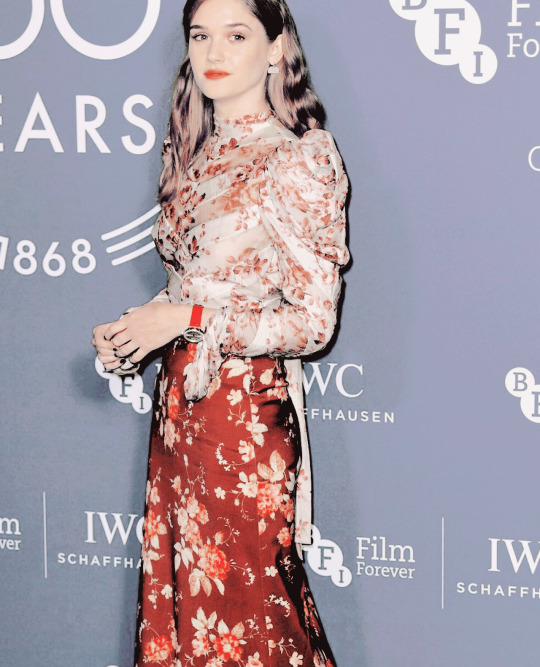

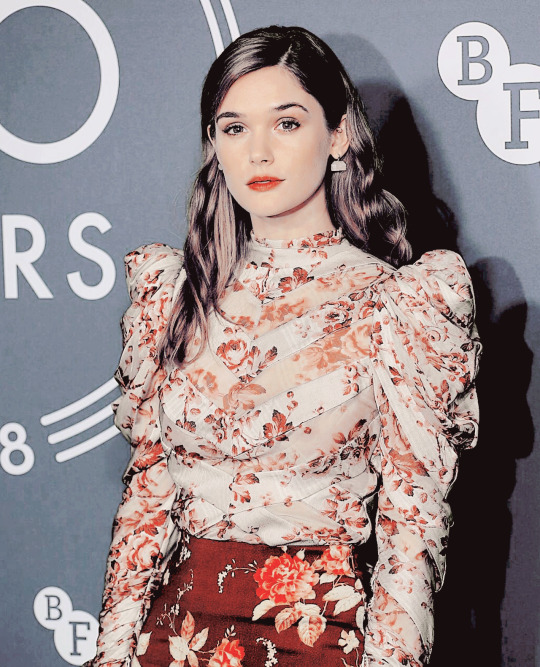


what would your character wear to the 2022 met gala ?
torvi would 10000% be on theme, taking inspiration from the gilded age fashions-- specifically from the tea gowns of the time. the puffy & structured sleeves, pattern and silhouette all take cues from the transitioning period between victorian & edwardian fashion.
tagged by: @viperbit
tagging: everyone
#( ans. ) drowning my thoughts out with the sounds#( vis. ) bigger than my body & colder than this home#( yes i actually did a small amount of research lmao. )
2 notes
·
View notes
Text
Pince-nez have experienced a recent surge in popularity as part of a larger comeback of Victorian and Edwardian fashion. The small, round frames of the glasses have become popular among both men and women as a symbol of sophistication and a unique fashion statement.
The popularity of pince-nez are due to many aspects of the fashion accessory. The pince-nezframe sits higher above the nose than standard eyeglasses, giving them a much more distinguished and refined look. The small frames, which typically have a nose clip in front of the lenses, alsohug the face in a flattering way that flatters the features and draws attention. In addition, pince-nez look great with many styles of hats and other fashion accessories.
Apart from their fashionable appeal, pince-nez have practical benefits as well. The glasses can be easily tucked away when not in use, allowing for much more convenience than most other types of eyeglasses. This is especially useful when paired with a hat, as it creates a seamless transition between dismal and fashion-forward, without the hassle of constantly having to adjust or take off glasses.
Finally, the durability of the pince-nez ensures that they will last for many years to come. The small frames have only a few pieces of metal, which makes them more resilient to breaking and scratching. As such, pince-nez are a fantastic investment for people who want to look their best without fear of having their frames break or get scratched.
In conclusion, pince-nez are an incredibly fashionable and practical fashion accessory. The distinguished frame and nose-clip make them stand out from the crowd and pair well with hats and other accessories. They are also very durable and can easily be tucked away when not needed, reducing the hassle of constantly adjusting eyeglasses. All in all, pince-nez are the perfect choice for people who want to look their best and be ready for whatever the day may bring.
0 notes
Text
Antique Yellow Gold Rings: Unveiling the Charms of Vintage Jewelry
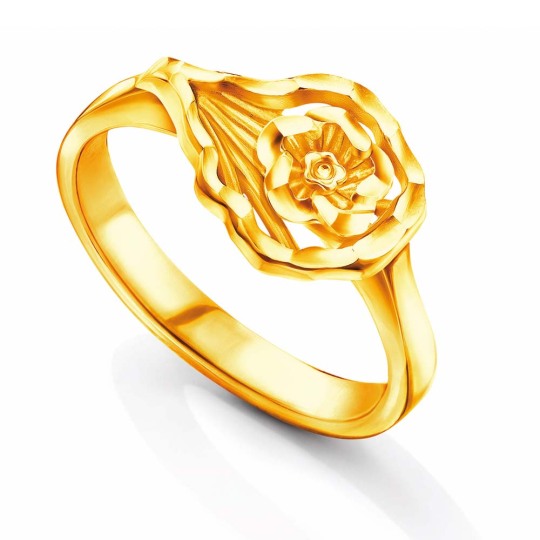
Antique yellow gold rings hold a timeless allure that transcends eras. These exquisite pieces of vintage jewellery tell stories of history, romance, and craftsmanship that continue to captivate jewellery enthusiasts and collectors. Through this article, we will delve into the fascinating world of antique yellow gold rings, unveiling the unique charms that make them treasures of the past.
1. A Glimpse into History
Antique yellow gold rings often carry with them a piece of history. They can be traced back to different periods, such as the Victorian, Edwardian, Art Nouveau, and Art Deco eras. Each era brings distinct design elements, reflecting the culture and trends of the time. For example, Victorian rings are known for their romantic motifs, while Art Deco pieces showcase geometric and abstract designs.
2. Unparalleled Craftsmanship
One of the most compelling aspects of antique yellow gold rings is the unparalleled craftsmanship that went into creating them. Before the advent of modern technology, jewellers meticulously handcrafted each piece. The attention to detail and dedication to their craft are evident in the intricate designs and precision of these rings. Intricate filigree work, delicate engravings, and the use of various gemstones characterize the quality of antique jewellery craftsmanship.
3. Unique Gemstone Combinations
Antique yellow gold rings often feature a wide array of gemstones. While diamonds were popular, coloured gemstones like sapphires, rubies, and emeralds were also commonly used. These rings frequently employed unique combinations of stones to create distinctive and eye-catching designs. These gemstones, paired with the warm, rich hue of yellow gold, added a sense of opulence to the jewellery.
4. Sentimental and Symbolic Design
Many antique yellow gold rings carried sentimental and symbolic meanings. For instance, acrostic rings spelt out messages through the first letter of each gemstone, expressing sentiments like "regard" (Ruby, Emerald, Garnet, Amethyst, Ruby, Diamond) or "dearest" (Diamond, Emerald, Amethyst, Ruby, Emerald, Sapphire, Topaz). These rings were not only fashionable but also deeply meaningful.
5. Investment Value and Rarity
Antique yellow gold rings are often considered valuable investments. Their rarity and historical significance contribute to their desirability in the collector's market. These rings, when well-maintained, can appreciate over time, making them both sentimental and financial assets.
6. Timeless Appeal
Perhaps the most significant charm of antique yellow gold rings is their timeless appeal. These pieces continue to be relevant and cherished, transcending the boundaries of fashion trends. Whether worn as engagement rings, family heirlooms, or statement jewellery, they never go out of style.
Gold ring for men
Gold rings for men are a timeless symbol of sophistication and style. These rings come in a wide range of designs, from classic and simple bands to more intricate styles with gemstone accents. Gold's warm, rich hue complements various skin tones and can seamlessly transition from casual to formal occasions. A simple gold band exudes understated elegance and can be worn daily as a symbol of commitment or as a statement piece. For a bolder look, men can opt for yellow gold rings featuring diamonds, onyx, or other gemstones, adding a touch of luxury and personality. Whether as a wedding band, an accessory for a special event, or an everyday fashion statement, gold rings for men are a versatile choice that effortlessly combines tradition and contemporary style.
How to style with antique gold rings with various outfit
Styling antique gold rings with various outfits is a versatile and creative process that allows you to infuse a touch of vintage charm into your look. These rings can complement different ensembles, whether you're going for a casual or formal appearance. When wearing antique gold rings with casual attire, such as jeans and a T-shirt, opt for a single statement ring on your middle or index finger for an effortless yet chic effect. For more formal occasions, consider pairing your antique gold ring with an elegant dress or tailored suit, allowing the ring to become a focal point of your ensemble. Additionally, antique gold rings work beautifully with bohemian-style clothing, enhancing the free-spirited and eclectic look. In all cases, coordinating the colours and styles of your antique gold rings with your outfits is key to achieving a polished and harmonious appearance. Whether you're embracing a vintage aesthetic or adding a unique element to modern fashion, antique gold rings provide endless possibilities for expression and style.
In conclusion, antique yellow gold rings are more than just pieces of jewellery; they are a testament to the artistry, history, and sentiment of bygone eras. Owning one of these rings means owning a piece of history, a work of art, and a treasure that can be passed down through generations. Their enduring charm and beauty continue to make them highly sought-after and cherished pieces in the world of vintage jewellery.
Author's bio: The author of this article has been crafting yellow gold, diamond, and other custom jewellery for many years successfully while working in a jewellery retail shop for decades.
0 notes
Text
chapter 1 end notes
Some historical notes:
The Chautauqua Movement began in New York State towards the end of the nineteenth century. It was an educational movement that quickly spread through the US, emphasizing teaching and self-improvement. In the Western US, like Colorado where this story is set, these goals somewhat overlapped with progressive-era interest in natural beauty and physical fitness and Chautauqua sites became places for tourism with a self-improving bent. For context: Teddy Roosevelt is also creating national parks, and museums are becoming increasingly publicly accessible at this time– there was a huge sense that people wanted entertainment and fun that they could feel was also fairly edifying. In this fic, Ed is a little skeptical of these goals, but that has as much to do with his reluctance to see his city change as anything else. You can still visit the Chautauqua Park in Boulder, CO today– and I believe the site in NY as well.
The summer of 1903, when this fic takes place, was a major year for the Boulder Chautauqua: it hosted Rischar’s brass band (referenced in this fic) for the entire season and hit a major heyday of social and educational events. You can see images of Rischar’s band here: https://localhistory.boulderlibrary.org/islandora/object/islandora%3A71893
and find more info on the Chautauqua here: https://www.chautauqua.com/2021/chautauqua-movement-history/)
The Daily Camera, the paper Ed writes for, was a real newspaper in Boulder in 1903, and is still the town’s paper today. Greyson, the newspaper editor in this fic, is completely made up. I have no idea if the Camera ran a social column, but they were very popular in other daily papers of the time. Extant copies I’ve seen of papers from New York State include everything from who was hosting dinner parties, what musicians and lecturers were touring nearby towns, who was hiring for what kind of jobs, not to mention life milestone announcements like weddings and funerals. Daily periodicals were super important to community life in the past, and now are a great way to learn about what the average day might have looked like at the turn of the century. The society pages were typically written by women reporters, or were assembled from notes that people sent in to the editor announcing whatever events they were hosting or attending– it would have been pretty unusual for a field reporter like Ed to be moved from ‘real’ news to these columns, but I’ve taken artistic liberty there because I just love giving that man stuff to be grumpy about.
The Crags mountains which are referenced throughout the fic are better known today as the Flatirons. All of the trails that Ed and Stede hike in this fic are trails that still exist today.
Conway’s Saloon was also a real place, and was situated at 1147 Pearl Street. The CO Carnegie Library has some great images of the interior of this historic bar, which is now a clothing store on the Pearl Street Mall.
I have slightly stretched the truth when it comes to the Hotel Boulderado: the hotel didn’t open until 1909, but it is such a magical landmark that I couldn’t resist including it here. (there’s some beautiful historic images of the interior and more info on the hotel website: https://www.boulderado.com/about/)
There’s also quite a bit of detail I include about fashion of the period. it’s such an interesting time of transition from the stuffiness of the gilded age to more relaxed eras, especially in a frontier context like the Rockies where people were constantly moving through, introducing new trends from back east and beyond. there are also some very real environmental conditions that make some of the more impractical edwardian elements passé more quickly. If people are interested, I’ll put together a lookbook but here are some links for good overviews of the fashions featured in this fic: https://victorian-era.org/edwardian-era-mens-clothing.html , https://www.filson.com/blog/field-notes/evolution-of-mountaineering-gear/ .
I used the amazing Chris Woodyard’s information about the fashions for men’s bathing suits in this time period when thinking up Stede’s outfit for the Boulder Creek excursion, though I have stretched the truth a little bit. Chris’ work is such a treasure, as she’s an expert on 19th and early 20th century newspapers and has made so many resources digitally available. Also, if you like the macabre, she has great books on Victorian death ideology and hauntings. https://mrsdaffodildigresses.wordpress.com/tag/edwardian-mens-bathing-suits/
The steamboat travel guide that Ed reads was real, published in NY in 1902. I have no idea if it was boring or not, sorry for potentially unfairly roasting the memory of one Cromwell Childe.
0 notes
Text
Timeless Elegance: Vintage Revival in Bracelet Fashion for 2023

Fashion is cyclical, and this is particularly true in the world of jewelry. In 2023, we are witnessing a resurgence of Vintage-Inspired Bracelet Designs that evoke the elegance and glamour of bygone eras. The allure of vintage jewelry lies in its intricate craftsmanship, unique designs, and nostalgic charm, making it a captivating choice for those seeking a touch of timelessness in their accessories. Let's explore the captivating world of vintage revival in bracelet fashion for 2023.
A Journey Back in Time: The Appeal of Vintage Bracelets
In a fast-paced and ever-changing world, vintage jewelry offers a connection to the past and a sense of nostalgia. The elegance of vintage-inspired bracelets lies in their ability to transcend time and effortlessly blend with contemporary styles. These bracelets carry stories of eras long gone, each piece reflecting the artistry and cultural influences of its time.
Art Deco Revival: Geometric Glamour
One of the most prominent vintage styles making a comeback is Art Deco. Characterized by bold geometric shapes, sleek lines, and intricate detailing, Art Deco bracelets exude a sense of opulence and sophistication. In 2023, we see Art Deco-inspired bracelets with marquise and emerald-cut gemstones, intricate metalwork, and symmetrical patterns, capturing the essence of the Roaring Twenties.
Victorian Elegance: Ornate and Romantic
The Victorian era brings a sense of romance and femininity to vintage bracelets. Delicate filigree work, floral motifs, and intricate scroll designs adorn these bracelets, showcasing the craftsmanship of the era. In 2023, Victorian-inspired bracelets are gaining popularity, appealing to those with a penchant for the whimsical and ornate.
Retro Chic: 1950s Glamour
The 1950s saw a shift towards femininity and glamour in jewelry design. Retro-inspired bracelets in 2023 feature bold statement pieces with oversized gemstones, curvaceous lines, and playful designs. These bracelets are a nod to the elegance and charisma of iconic Hollywood stars, bringing a touch of vintage glamor to modern wardrobes.
Edwardian Splendor: Graceful and Refined
With the Edwardian era came a focus on light and airy jewelry designs. Bracelets from this era often feature intricate lacy patterns, milgrain detailing, and elegant bows. In 2023, Edwardian-inspired bracelets exude a timeless and refined charm, appealing to those who appreciate graceful and delicate aesthetics.
Art Nouveau: Nature's Inspiration
Art Nouveau's influence can be seen in jewelry designs that draw inspiration from nature. In 2023, bracelets with flowing lines, floral motifs, and organic shapes capture the essence of this unique and enchanting art movement. These pieces appeal to those who seek a connection with nature and a touch of artistic individuality.
Revamped Retro: Modernizing Vintage Designs
While vintage-inspired bracelets are making a resurgence, designers are infusing modern elements to create fresh and exciting pieces. Combining vintage aesthetics with contemporary materials and techniques, these bracelets cater to the tastes of the modern fashion-conscious individual. This blending of old and new allows wearers to embrace nostalgia while staying relevant in the present.
Materials and Finishes
In 2023, vintage-inspired bracelets often use a combination of traditional and modern materials. Rose gold and yellow gold continue to be popular choices, lending warmth and richness to the designs. Mixed metals, such as gold and silver, offer a contemporary twist. Furthermore, antique finishes and milgrain detailing add an authentic vintage touch.
Versatility and Timelessness
The beauty of vintage revival bracelets lies in their versatility. These pieces seamlessly transition from casual to formal settings, complementing a wide range of outfits and occasions. Whether paired with a vintage-inspired dress for a retro-chic look or used to add a touch of timeless elegance to modern attire, these bracelets are a standout accessory in any ensemble.
A Treasure to Pass On
Beyond their beauty and elegance, vintage revival bracelets often become cherished heirlooms. The idea of owning a piece of history that can be passed down through generations adds a sentimental value that modern jewelry might not always evoke. This sentimentality makes vintage-inspired bracelets all the more meaningful and enduring.
Conclusion
The vintage revival in bracelet fashion for 2023 offers a captivating journey through time, with styles ranging from the opulence of Art Deco to the delicate grace of Edwardian designs. These bracelets embody elegance, nostalgia, and a connection to the past, resonating with those who appreciate the beauty of bygone eras. With their timeless appeal and ability to infuse contemporary wardrobes with sophistication, vintage-inspired bracelets are destined to remain a prominent trend in the world of jewelry fashion for years to come.
1 note
·
View note
Text
Things about me:
She/her
I am a queer, POC, cis woman (TERFs /GC DNI)
Vegetarian and very concerned about climate change
I like reading a lot of stuff like mangas and comics in general, books, novels, fanfiction. (Send me recommendations of things with queer rep and I'll send you a little kiss)
I'm bad at art but I love it (NO AI)
I have an obsessive with zombies for many years now and I will tell you all about if you let me
I also like a lot of old style fashion (Victorian, Edwardian, etc) and i really need to start learning how to sew
passionate about cycling, and public transit (lol)
I like video games! I'm not good but I play a lot of Minecraft
Kinda new on Tumblr hope we can be friends ♥️♥️
Oh and I picked this name cause flowers are pretty and I read a book about flower language where lily's where described as "return to happiness" and I thought that sounded nice and cute
#new to tumblr#queer woman of color#i love cats#fanfiction#comics#pretty flowers#fashion#zombies are neat
0 notes
Text
Ryan and Shane discuss historical clothing again (And how much it weighed)
...and look, I love historical fashion now, so I WILL make posts about it. The last note I made was during that episode of BFU with Lizzie Borden. Again using information from Izabela Pitcher, who is a historical constumer from the medieval ages to the Edwardian era.
Edit: I do know a lot about historical fashion, but I am still relatively new, so seek further information!
BEFORE we get into weight, here's a video showing everything she can do in a corset. Here's one with her fencing in Victorian attire. Or one where a historical event she attended happened to be near a park. So you can move in historical clothing.
The video Izabela Pitcher made weighing her clothing.
The heaviest clothing from the video is from the Tudor era, around the 16th century, considered to be the end of the "medieval period" and the transition to the "modern era." A court gown weighs 7 kilograms or about 15 pounds. This sounds ridiculous, but we are talking about the 16th century here, which was a time for ridiculous royal clothing (less fancy dress would have weighed a lot less). Here is a bit of my Pinterest board for 16th-century clothing:

On the lighter end of the outfits she weighed, was Regency (specifically 1815), at around 2kg or 4 pounds. What I have in my 1800 and 1810 folders:


Yeah, you may be asking, what about the woman in her wedding dress?????? Izabela Pitcher did not weigh her wedding gown, but she does have a video about the layers that would have gone into one from the 1880s. Which, you know, she rode a horse on, danced in, etc.
This video shows both a seaside Victorian outfit and a swimming outfit. She -shocker!- does not drop like a stone when she goes into the water.
Wet clothing is no fun- my swimming school when I was little and learning to swim had you wear clothing some of the days so you could get used to it, in case you fell off a boat or something. My parents apparently decided they didn't want a weakling and sent me to lessons in a woolen jumpsuit once. That was not fun, but I learned how to keep myself afloat.
TL;DR (but you should, historical fashion has been fascinating to learn about!):
Historical clothing didn't wear a ton unless you were rich and fully kitted out in fancy gear. Thanks for coming to my TED talk.
0 notes
Photo

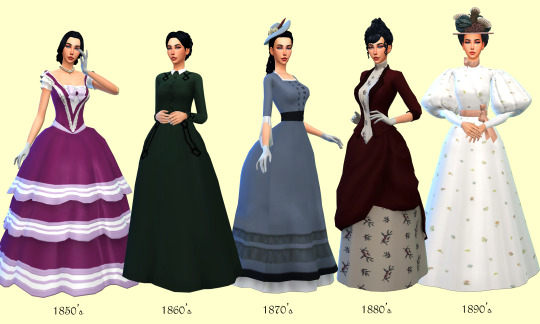
19th Century Fashion Evolution Lookbook
Since a few months ago, I wanted to make a lookbook about the female fashion evolution throughout the 19th century and their respective decades.
The century starts with the typical empire silhouette dresses from the Late Georgian and Regency eras (1800′s-1810′s). 1820′s and 1830′s was a transitional decades from the narrow empire gowns to breadth dresses with exaggerated puffy sleeves. Early-Mid Victorian (1840′s-1860′s) fashion is characterized by the increase in the width of women skirts with the use of the crinoline. In Mid-Late Victorian (1870′s-1880′s) era, sinhouettes became narrow again and the bustle was used for get a draped shape. In the Last 19th Century Decade (1890′s), puffy sleeves comeback, skirts acquire a A-line shape and fashion style becomes a transition from the victorian to the edwardian era.
I hope you like it. I’m not a professional fashion historian, only a vintage-style lover. And sorry for my bad english.
Thanks for @sifix @stephanine-sims @historicalsimslife @peebsplays @buzzardly28 @linzlu @vintagesimstress @elfdor @dancemachinetrait @coloresurbanos @teanmoon @simstomaggie @dzifasims @gilded-ghosts @plumbobteasociety @zurkdesign @ivkasims @pralinesims @goppolsme @kijiko-sims @nords-sims and @pyxiidis for their amazing and wonderful CC <3
CC links under the cut
1800′s: Hair/Dress/Gloves
1810′s: Hair/Dress/Gloves/Necklace
1820′s: Hair/Dress/Gloves
1830′s: Hair/Dress/Necklace
1840′s: Hair/Dress/Bonnet
1850′s: Hair/Dress/Necklace/Gloves
1860′s: Hair/Dress
1870′s: Hair/Dress/Hat
1880′s: Hair/Dress/Gloves
1890′s: Hair/Dress/Hat
Sim Genetics: Skin/Eyes/Eyelashes/Natural Lips/Blush/Nosemask
Enjoy and Happy Simming!
#historical lookbook#regency#regency lookbook#victorian#victorian lookbook#19th century#ts4#ts4cc#ts4 historical#ts4 lookbook#sims 4#sims 4 lookbook#sims 4 historical#historical sims#lookbook
439 notes
·
View notes
Text
New Corsetry
Settling into a new pattern shape here in the work studio…the fashion geometry changes so much every few years! This feels different from my “usual” 1880s style, but somehow I have better posture. Late Victorian, not quite Edwardian…definitely: “transitional”.
Become a Patron!
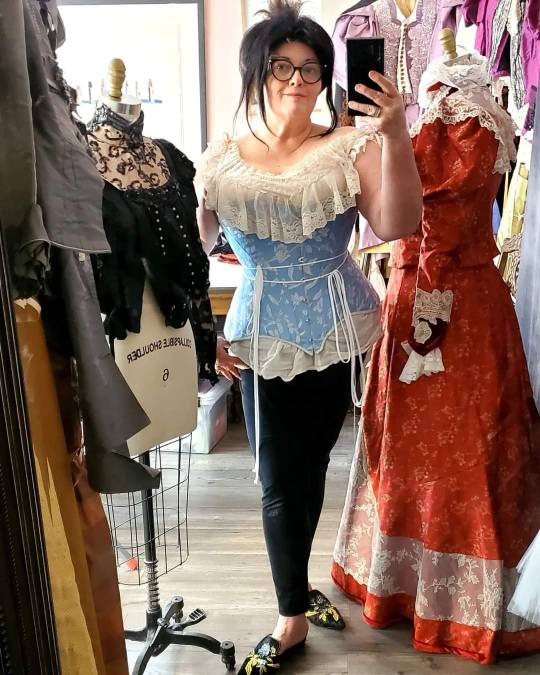
View On WordPress
#1890s#1900s#Atelier Lily Absinthe#Best In The West#Corset#Corsetiere#Corsetry#Corsets#Edwardian#Edwardian Fashionista#Hollywood Victorian#Karin K. McKechnie-Lid#Lily Absinthe Gowns and Corsetry#The Edwardian Designer#The Victorian Designer#Victorian#Victorian Dress#Victorian Fashionista
7 notes
·
View notes
Note
hey love what era is marcelle being dressed in?
cause i’ve always assumed ikevamp is set at the end of the regency? due to napoleon dying in 1821? and him only being at the mansion for maybe about 6/7 months? and i know comte is a time traveller but like the huge sleeves thing is very 1830s thing. they didn’t start to get bigger until the later half of the 20s as they were still phasing out from the neoclassical silhouette of the regency? transitional periods am i right?
this is isn’t me being pedantic i’m just interested is all!! also means i can send in some more fashion plates i find 👀
cause i found a very similar plate to what marcelle is wearing from 1821:

personally i’m more partial to late victorian children’s fashion (circa 1870) but the 1830s is one of my favourite decades for fashion in general, especially eveningwear 🥰.
So it’s been predicted that ikevamp happens in around 1890-1899 due to a couple of things that people have caught in the speeches of the characters. That’s where I based this off. She’s dressed in a semi-1890s fashion but I feel like Comte would want her to have a more classical feel that’s why she takes some references from older times. Comte said he was a fan of regency fashion. 1820-40s are an amazing time for fashion, I agree as a textiles fashion student!! ☺️☺️ yes that little dress is adorable 😭
These are some model 1890-1899 fashion for young girls that I took inspiration from:
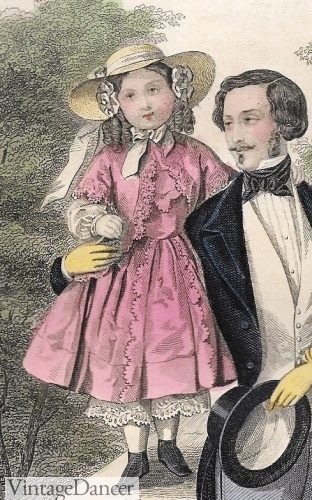



And this is a late 1880s model:
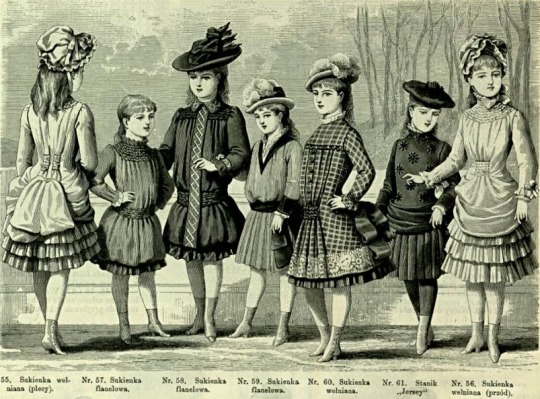
As you can see they still have the puffy sleeves going on too.
The Edwardian period (1901-1910) had a massive use of the ‘puffy’ sleeves or gigot sleeves to achieve an hourglass shape in women. (See picture below) Of course this wasn’t the same for children but children’s wear is always influenced by adult fashion.
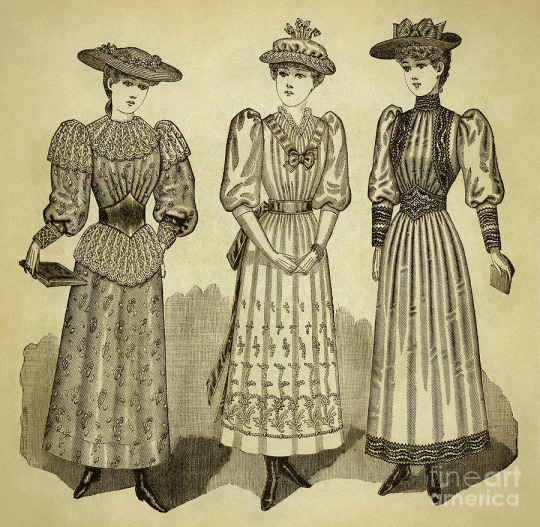
These are some early Edwardian childrens wear:


Albeit that their sleeves got shorter, the sleeves didn’t become tight fitting just yet. This is why it was such a shock when the First World War broke out. People needed the fabric to make basic clothes therefore these iconic silhouettes were finished and more tighter-shorter clothing was implemented.

Puffy sleeves as a major part of the fashion in the century. It gave them nice rounded shoulders and flattered the mass of skirts they used to wear. (If you could afford it of course) so yeah marcelles dress is a mixture because whilst we predict it’s based in 1890s but we don’t know for sure. So I went for a typical mid-Victoria look, with more details from the 1890s than other decades, I hope that explains things?? 😅☺️
12 notes
·
View notes
Text
Aphrodite as 100 years of Greek fashion (part 1)
Before writing this long essay post, I just wanted to give props and citations of information to both @alatismeni-theitsa and @greek-mythologies for introducing me a lot of things about Greek arts, culture, and its past history over several months now; and that this idea was also partly inspired from the common idea of modern Hellenic Polytheists as well: that “the gods are often enormously powerful beings who don’t have definitive physical bodies, and they often manifest/appear to whomsoever they wish and in any form that they wish to.” To me, since both Aphrodite and Ares have always been appeared as local Mediterranean Greeks in modern-day clothing fashion, here are some photos of what the couple themselves would wear/ dress like for over past 100 years ago.
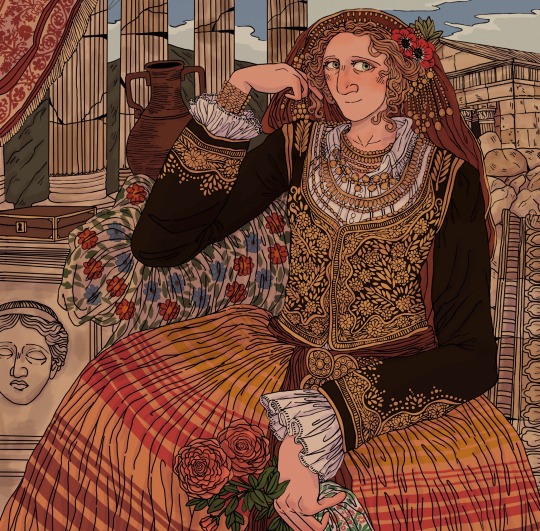
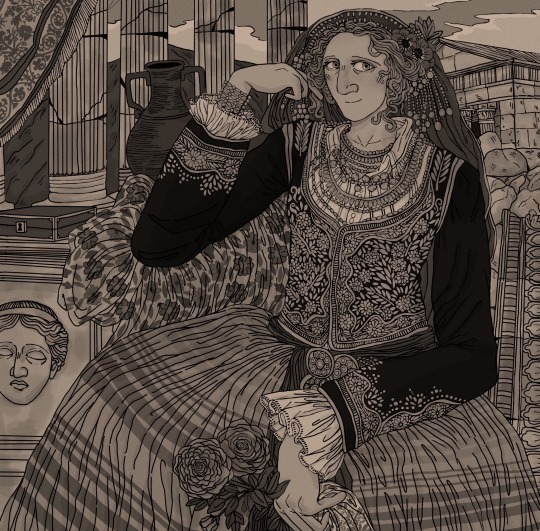
1910s:
During this time and era, Western European fashion from the Edwardian era haven't reached to most of the Greek population, yet; and only to be worn by the royal aristocratic class and the affluent wealthy class. It was much more transition period due to the effects of Second Industrial Revolution, to be exact. Villagers who lived in both rural and developing areas back then often wore the traditional clothing (paradosiaki foresia), consisted of a simpler attire: shirt, skirt, apron, and handkerchief for women. (Even though this is not really a case for all the affluent wealthy class, as sometimes they wore traditional fashion or a fusion mix between both modern and traditional, in some occasions.) Aphrodite, in this case here, as the goddess of sex, love and beauty, wore “the traditional folk kaprasia bridal dress” from the island of Cyprus as usual, with the traditional ornate golden jewelry that Greek Cypriot families often passed down from generations to generations.
Historically, this is also the time when all countries in the Balkan region (Greece, Bulgaria and Serbia) forming allies together in order to help smaller European territories to gain independence from the ever slowly-dying Ottoman Empire; but later turn hostile towards to each other due to the partitioning of their conquests. The political Greek royal family and the Greek Prime Minister also began to ripping the Greek society apart; as Konstantinos I was married to Kaiser Wilheim II’s sister while the Greek government Eleftherios Venizelos was allied with the Allied Powers, British Empire, and France. This period of time, also marked “one of the largest chain of tragedies and sadnesses within the modern Greek history”; as the famous Greek genocides were being committed in the Anatolia region of Turkey, on the basis of their religion and ethnicity. With the fall of the Ottoman Empire and the assassination of Franz Ferdinand of Austro-Hungarian Empire, and other problem factors that related to “Socio-Darwinism” and “colonialism” across Africa and Asia, World War I begins and Greece declares war on the Central Powers in 1914, ending three years of neutrality by entering World War I alongside Britain, France, Russia, and Italy.


1920s:
During this time and era, Europe just formed a fragile peace treaty together and WW1 had made a fundamental and irreversible effect on society, culture, and fashion; where women’s fashion were all often associated with the ideas of “letting loose”, “breaking free” and “rebel against” the physical and social constraints of the previous century. Letting go away from the extravagant and restrictive styles of the Victorian and Edwardian periods, and towards a more simple, more casual chic, and looser clothing which revealed more of the flowing silhouette, the arms and the legs. This idea might have originally started in Paris and popularized by Gabrielle Chanel, paralleling with the idea of “women’s participation on the war, have the right to vote and entering the workforce to win her own liberty” -which later spread to many parts of urban cities across the Americas and Western Europe. Despite this, since Greece has always been much more socially-culturally modest and much more conservative than other Northern European countries during this time: it is either that Greek women embraced these new long flowy dresses where their skin was less revealed, or that women still embraced the dresses from the past Victorian-Edwardian eras. (But I personally think that Aphrodite herself would passionately embraced these new minimalist flapper-like looks, to be honest.)
Aphrodite’s dress and hairstyle in here was inspired from Princess Aspasia Manos of Denmark and Greece, and Queen Victoria Eugénie of Battenberg and Spain; since during this time, high end fashion trends were now become much more cheaper and affordable to people who coming from the middle working classes. The jewelry that she wore around her neck were the strands of pearls - one of the common characteristic that was popularized by Gabrielle Chanel during that time and had always been considered as “the sacred stone of love” to the goddess herself back in the ancient times- and a necklace of red coral beads. Her once ancient golden jewelry is now remodeled and incorporated with new gemstones, which was a kind of common case during that time, too. Her husband, the god Ares here wore the usual local traditional fustanella from the region of Thessaloniki-Macedonia that you guys had saw in my previous drawings. The architectural background was based on one of the oldest and the most beautiful neighborhoods in modern city of Athens, Plaka and several other neoclassical architectural pieces around the city’s center.
#aphrodite#ares and aphrodite#ares#mars and venus#mars#venus#modern day greek mythology#100 years of fashion#100 years of beauty#greek history#paradosiaki foresia#my art#kaprasian bridal dress#100 years of Greek fashion#1910s fashion#1920s fashion
107 notes
·
View notes
Text
Part V – America: Independence (1700 – 1800)
Surprisingly, I’ve managed to organise my day that I have more free time than I expected. So, here we go with another post in such a short amount of time.

America:
In the 18th century, Alfred would have gone ahead to slowly shake off all the Puritanism that marked his beginnings. The plain clothing would, for a large part, be tucked away in chests and creates. While the fashion got more luxurious, it still remained simple thanks to the Quakers. That meant that while would have started to wear clothes with lace at the tight sleeve cuffs, all his garments would have been devoid of rich embroidery and brocade and braid. Therefore, his clothing would always be of the best quality that he could get his hands on – the softest leather, the finest silk, the best cotton.
In this century, America would have transitioned between childhood and adulthood quickly in nation terms. He would have also tried to show it in order to convince England that he was old enough to take some matters in his own hands – go around with a cane, making sure his posture was straight in good company and making sure to make manly strides. And also wearing breeches that showed off his calves and a waistcoat that tapered his waist.
Yet he would eventually realise that no matter how much he tried to act like an adult, the snide remarks would still come his way. While Alfred would forsake his attempts to cordially convince his dear Lord Father to hand him more rights, and thus stop putting that much effort in fashion, some vestiges of that would always remain. As in a preference for finer stuff if he would have to dress formally and being conscious of how much appearance could reflect personality.
During the revolutionary war, he’d opt to wear causal clothing, reminiscent of his simple beginnings, when he wouldn’t be in his uniform. He’d also take care of his uniform like a holy grail. The rebel army was running on foreign funds and the amounts of uniforms a soldier could get were one. That when he wasn’t flinging away all his concerns about clothing in order to fight for his freedom, he would be stuffing holes and trying his best to get the blood out.
Wigs weren’t so much the rage as they were in Europe. That means there would have been no wigs for Alfred. Instead, he would have grown out his hair to shoulder length and tied it make in a queue.
Part I – On the fashion attitudes of England and America
Part II – England: The early years (950 – 1400)
Part III - America: The early years (1600 - 1700)
Part IV - England - The Tudors (1400 - 1600)
Part V – America: Independence (1700 – 1800)
Part VI – England: The Stuarts (1600 – 1700)
Part VII – England: The Georgian Era (1700 – 1830)
Part VIII – America: The Civil War & The Gilded Age (1800 – 1900)
Part IX – England: The Victorian Era (1830 – 1901)
Part IX – England: The Victorian Era (1830 – 1901)
Part X – England & America – Edwardian Era to Roaring 20s (1900 – 1929)
Part XI – England & America – Great Depression to post-WWII (1930 – 1949)
Part XII – England & America: Cold War Part I (1950 – 60)
14 notes
·
View notes